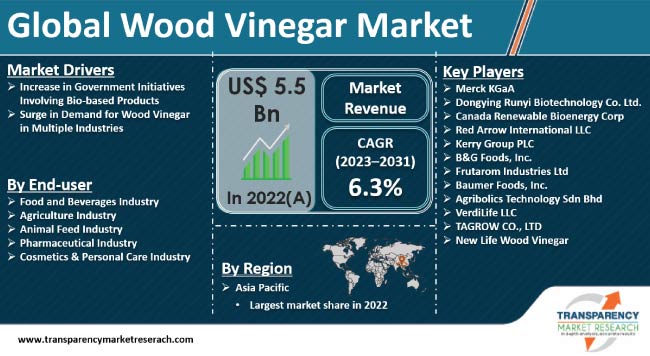Impact Assessment of COVID-19 Outbreak on Wood Vinegar Market
Food and beverages manufacturers, today, are responding by reformulating products and providing clean label products. Processed food manufacturers are focusing on investing in the expansion of existing production plants, and setting up of new plants to increase the production of processed food such as meat and seafood products. This, in turn, is expected to boost the demand for liquid smoke/wood vinegar that is used to add a distinct flavour in certain processed food products.
Enquiry Before Buying:https://www.transparencymarketresearch.com/sample/sample.php?flag=EB&rep_id=18314
Wood vinegar manufacturers across the globe are increasingly focusing on using different types of wood as raw materials to produce products with distinct flavors. In addition, these manufacturers also focus on blending two or more raw materials for product differentiation. The global wood vinegar market is, however, currently restrained by the lack of consumer awareness about liquid smoke products in certain developing countries. Revenue generated from wood vinegar market was approximately US$ 1,295.4 Mn in 2017 and is expected to increase at a CAGR of 4.9% over the forecast period, 2017-2025. By the end of 2025, the market is expected to be valued at around US$ 1,896.8 Mn.

Buy Now :https://www.transparencymarketresearch.com/checkout.php?rep_id=18314<ype=S
Trends among Manufacturers & Consumers
Wood vinegar is a by-product of charcoal production, and is produced from the destructive distillation of wood. Wood vinegar has several applications where it can be used as a natural plant-derived pesticide, herbicide, plant growth promoter, fungal growth enhancer, and in several other applications. Biomass-based products are becoming immensely attractive, and the introduction of effective and more efficient pyrolysis technologies has improved overall yield, resulting in valuable production generation. Furthermore, the growing consumer demand for organic food products is compelling manufacturers to bring in all 'natural' and 'organic' products to the marketplace. This has, in turn, fueled farmers’ interest in organic farming, and hence, the concept of organic fertilizers and pesticides. Collaborative efforts to bring such products are in process, thus creating opportunity for the market growth of wood vinegar in the near future.
Companies in the market are focusing on new product launches, and brining products in the marketplace that are natural and at the same time very affordable. Wood vinegar is obtained from charcoal, and is widely used in the agriculture industry in order to improve the overall production of crops. Wood vinegar acts as a fertilizer, where it improves soil fertility, allows better uptake, and reduction of up to 50% of fertilizers, herbicides, and pesticides. Manufacturers of wood vinegar need to efficiently meet the requirements of various end users in different applications, while ensuring the supply of the required products, as quality and positive outcome are of utmost importance to the end-use industry.
Explore Transparency Market Research’s award-winning coverage of the global Industry:https://www.prnewswire.com/news-releases/chp-combined-heat-and-power-installation-market-to-expand-with-advancements-in-thermal-energy-management-tmr-301196709.html
Key Limitations to Market Growth
Some of the restraints that are potentially restricting the growth of the wood vinegar market is that wood vinegar is produced from several organic sources. However, there are various challenges associated with the sourcing and manufacturing of wood vinegar from these similar natural sources, which may lead to repeatable/dependable results, thus limiting their use across several industrial domains. Furthermore, much of the wood needed for charcoal production comes from natural forests, leading to forest harvesting. Charcoal production is one of the major reasons for deforestation across the globe. As the standard of living across developed and developing countries rises, the demand for charcoal and its by-products, including wood vinegar for energy production, also increases. This has pushed governments to release regulations on the production and distribution of charcoal and its derivatives, thus limiting overall charcoal production, hence the production of wood vinegar.
About Us :
Transparency Market Research is a global market intelligence company, providing global business information reports and services. Our exclusive blend of quantitative forecasting and trends analysis provides forward-looking insight for thousands of decision makers. Our experienced team of Analysts, Researchers, and Consultants, use proprietary data sources and various tools and techniques to gather, and analyze information.
Our data repository is continuously updated and revised by a team of research experts, so that it always reflects the latest trends and information. With a broad research and analysis capability, Transparency Market Research employs rigorous primary and secondary research techniques in developing distinctive data sets and research material for business reports.
Comments
Post a Comment